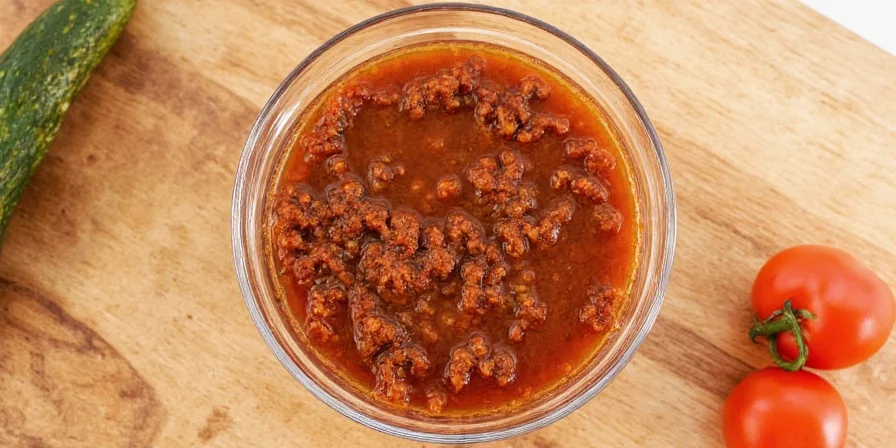Sofrito is a fundamental cooking base used across Latin American and Caribbean cuisines, typically made from sautéed onions, garlic, peppers, and herbs. Unlike mirepoix or soffritto, authentic sofrito contains acidic components like tomatoes or citrus that accelerate flavor extraction through pH chemistry. This guide provides precise recipes, regional variations, and troubleshooting methods to create restaurant-quality sofrito at home.
Table of Contents
- What Is Sofrito? (Simple Definition)
- Basic Sofrito Recipe for Beginners
- Core Ingredients and Substitutes
- Puerto Rican vs Cuban vs Dominican Sofrito
- Pro Tips for Perfect Texture and Flavor
- Troubleshooting Common Problems
- Frequently Asked Questions
- How to Store and Use Sofrito
What Is Sofrito? (Simple Definition)
Sofrito (Spanish for 'lightly fried') is a flavor foundation essential to Latin American cooking. While recipes vary by region, all authentic sofritos contain these key elements:
- Aromatic base: Onions, garlic, peppers
- Acid component: Tomatoes, citrus, or vinegar
- Fat medium: Olive oil, lard, or coconut oil
- Herb component: Culantro, cilantro, or recaito

Unlike French mirepoix (onions, carrots, celery), sofrito's acidic components create chemical reactions that extract flavors more efficiently. This is why dishes made with proper sofrito have deeper, more complex flavors than those using other cooking bases.
Basic Sofrito Recipe for Beginners
Perfect for your first attempt at making authentic sofrito:
- 2 cups yellow onions, finely diced
- 1 cup Cubanelle peppers, finely diced
- 8 garlic cloves, minced
- 1 cup cilantro or culantro, chopped
- 2 tbsp tomato paste
- 3 tbsp olive oil
- Salt to taste
Instructions: Heat oil over medium-low heat. Sauté onions for 5 minutes until translucent. Add peppers and cook 3 minutes. Stir in garlic and herbs, cooking 2 minutes until fragrant. Mix in tomato paste and cook 3 minutes until oil separates. Cool before using or freezing.
Core Ingredients and Substitutes
Authentic sofrito requires specific ingredients but offers flexibility for home cooks. Understanding these substitutions prevents flavor imbalances:
| Ingredient | Traditional Use | Best Substitutes |
|---|---|---|
| Yellow Onion | Provides balanced sweetness | White onion (sharper), Shallots (milder) |
| Cubanelle Pepper | Thin walls, citrus notes | Green bell pepper (less ideal), Aji dulce (authentic) |
| Culantro (Recaito) | Tropical alternative to cilantro | Cilantro (stronger flavor), Parsley (milder) |
| Tomato Paste | Acid component for flavor extraction | Fresh tomatoes (less concentrated), None for Spanish version |

Puerto Rican vs Cuban vs Dominican Sofrito
Each region has distinct sofrito characteristics based on historical ingredients:

Puerto Rican Sofrito (Recaito)
Features culantro (not cilantro), annatto oil, and no tomato. Culantro's tougher leaves withstand tropical climates better than cilantro. Key ratio: 2:1 onion to pepper.
Cuban Sofrito
Includes tomato sauce and cumin. Tomato addition reflects 19th-century US exports. Traditional ratio: equal parts onion, pepper, garlic.
Dominican Sofrito (Sazón)
Contains vinegar (often from mamajuana) and beer. Vinegar counters humidity-induced spoilage. Ratio: 3:1:1 onion-pepper-garlic.
Pro Tips for Perfect Texture and Flavor
Avoid common mistakes with these practical techniques:
- Chop size matters: 1/8-inch dice ensures even cooking (use a mandoline for consistency)
- Heat control: Maintain medium-low heat (325°F/160°C) to prevent burning garlic
- Order of operations: Onions first (higher smoke point), then peppers, garlic last
- Fat selection: Olive oil for Mediterranean dishes, lard for authentic Caribbean flavors
- Freezing method: Portion in ice cube trays, then transfer to freezer bags for up to 6 months

Troubleshooting Common Problems
Solve these frequent sofrito issues:
| Problem | Quick Fix | Prevention |
|---|---|---|
| Watery consistency | Add 1 tsp cornstarch while cooking | Sauté vegetables longer to remove moisture |
| Bitter taste | Stir in 1 tsp honey or lime juice | Don't burn garlic; cook over medium-low heat |
| Flat flavor | Add 1 tsp dried oregano or cumin | Toast spices before adding vegetables |
| Too strong aroma | Dilute with cooking liquid from your recipe | Reduce herb quantity by 25% in next batch |

Frequently Asked Questions
How is sofrito different from mirepoix?
Sofrito contains acidic components (tomatoes/citrus) that lower pH for better flavor extraction, while mirepoix (onions, carrots, celery) is French and used in stocks/soups without acid. Sofrito has stronger herbal notes and is foundational to Latin dishes.
Can I make sofrito without a blender?
Yes! Traditional sofrito is hand-chopped, not blended. Dice ingredients to 1/8-inch pieces for best flavor release. Blending creates a paste that cooks differently than the intended chunky texture.
How long does homemade sofrito last?
Refrigerated: 5-7 days in an airtight container with oil covering the top. Frozen: 6 months in ice cube trays. Never store at room temperature as it spoils quickly due to fresh ingredients.
What dishes use sofrito?
Sofrito is essential in arroz con pollo, paella, feijoada, sancocho, and many Latin American bean dishes. Use 1/4 to 1/2 cup per pound of meat or 2 cups of rice. Never skip sofrito in authentic recipes—it's the flavor foundation.
How to Store and Use Sofrito
For best results, freeze sofrito in 1/4-cup portions using silicone ice cube trays. Once frozen, transfer to labeled freezer bags with date and regional style (e.g., "Puerto Rican"). When cooking, add frozen sofrito directly to hot oil—no need to thaw. Properly made sofrito should have a rich, complex aroma with balanced sweet, savory, and herbal notes.

Mastering sofrito transforms simple ingredients into deeply flavorful dishes. Start with the basic recipe, then experiment with regional variations as you gain confidence. Your cooking will immediately improve with this essential flavor foundation.











 浙公网安备
33010002000092号
浙公网安备
33010002000092号 浙B2-20120091-4
浙B2-20120091-4